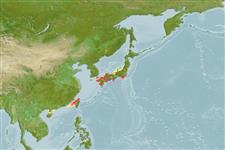Teleostei (teleosts) >
Callionymiformes (Dragonets) >
Callionymidae (Dragonets)
Etymology: Callionymus: Greek, kallion, comparative of kallos = beautiful + Greek, onyma = name; with a better name ; izuensis: Named for its type locality, Izu Island, Japan..
More on authors: Fricke & ZaiserBrownell.
Environment: milieu / climate zone / depth range / distribution range
Ecology
Marine; demersal; depth range 16 - 18 m (Ref. 11666). Temperate
Distribution
Countries | FAO areas | Ecosystems | Occurrences | Point map | Introductions | Faunafri
Northwest Pacific: Japan.
Size / Weight / Age
Maturity: Lm ? range ? - ? cm
Max length : 9.0 cm SL male/unsexed; (Ref. 42598); 8.3 cm SL (female)
Short description
Identification keys | Morphology | Morphometrics
Found on coarse sand, sometimes with broken shells and coral rubble (Ref. 11666).
Life cycle and mating behavior
Maturities | Reproduction | Spawnings | Egg(s) | Fecundities | Larvae
Fricke, R. and M.Z. Brownell, 1993. Two new dragonets of the genus Callionymus (Callionymidae) and a record of Callionymus corallinus from Miyake-jima, Izu Islands, Japan. Jap. J. Ichthyol. 40(1):1-10. (Ref. 11666)
IUCN Red List Status (Ref. 130435)
Threat to humans
Harmless
Human uses
Tools
Special reports
Download XML
Internet sources
Estimates based on models
Phylogenetic diversity index (Ref.
82804): PD
50 = 0.5000 [Uniqueness, from 0.5 = low to 2.0 = high].
Bayesian length-weight: a=0.00912 (0.00408 - 0.02036), b=2.77 (2.59 - 2.95), in cm total length, based on LWR estimates for this Genus-body shape (Ref.
93245).
Trophic level (Ref.
69278): 3.2 ±0.4 se; based on size and trophs of closest relatives
Resilience (Ref.
120179): High, minimum population doubling time less than 15 months (Preliminary K or Fecundity.).
Fishing Vulnerability (Ref.
59153): Low vulnerability (10 of 100).
